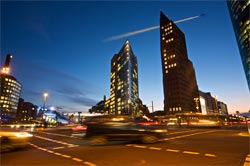Comprehensive security of built structures

How safe are high-rise buildings in the event of a plane crash? Special methods allow the calculation of exactly what the dynamic and structural loads are on buildings. © Fraunhofer EMI<br>
On October 24, 2001 a devastating fire broke out in the St. Gotthard Road Tunnel in Switzerland, costing eleven people their lives. The main traffic route through the Swiss Alps remained closed for more than two months following the disaster whilst extensive renovation works were carried out.
Tunnels are not the only structures that can be destabilized by major incidents; buildings can be so damaged by explosives or fires that they collapse. How can multi-story buildings, bridges or nuclear power stations be made safe? Researchers at the Fraunhofer Institute for High-Speed Dynamics, Ernst-Mach-Institute, EMI are working alongside colleagues from the Schüßler-Plan Group, an engineering consultancy, to develop concepts for the comprehensive safety of buildings and structures. This means building contractors will in future be able to access the EMI researchers’ expert knowledge at an early stage in the planning process. The guidelines are being realized by engineers from Schüßler-Plan as part of an interactive collaboration.
Risk analysis for building contractors
“Our collaboration supports building contractors from the initial planning stages right through to completion,” says Dr. Alexander Stolz of the EMI in Freiburg. “We provide safety assurances during the planning phase by testing those loads that could potentially affect the structure, and we support contractors by furnishing them with a risk analysis report.” Scientists at the institute benefit from having on-site facilities to investigate the effects an explosion has on built structures, either through trials involving real explosives or using their large shock tube, powerful enough to test storey-high test specimen. „We use the finite element method, which is a numerical technique, to check the validity of the trial, and can predict any event scenario we want.
Schüßler-Plan then converts the results into engineering models. Building contractors can be certain that the dynamic and structural loads on buildings were calculated exactly. On top of this, we use the newest and most innovative protective and high-performance materials – materials that are both developed and qualified by us,“ he explains. The team also deals with retrofitting existing constructions such as airports, subway stations or underground parking lots. The experts do more than just help to make individual buildings safer, they also introduce safety-relevant aspects into urban planning. Simulation tools are used to calculate the incredibly complex way a pressure wave spreads through a built-up area. This enables different designs for urban structures to be judged on aspects concerning their relative safety – and improvements to be made accordingly – all whilst still in the planning stages.
Clear escape routes in the event of a plane crash
The collaboration between Schüßler-Plan und the EMI came about as part of the “Secure high-rise buildings” project. Markus Nöldgen, a former Schüßler-Plan employee and currently a professor at Cologne University of Applied Sciences, was prompted by the airplane attack on the World Trade Center in New York to consider the statics of high-rise buildings. The result was an ingenious framework construction built around an inner core of Ultra High Performance Concrete (UHPC), which ensures escape routes are kept clear and accessible in the event of an aircraft impact.
Dr. Ingo Müllers, head of department at Schüßler-Plan, welcomes the collaboration with colleagues from Fraunhofer. The engineering consultancy has more than 50 years of market experience. “We’re delighted to now be able to offer our clients an additional service,” he says. The purchase of a single contract buys the client the expertise of both scientists and engineers. In fact the cooperation extends so far that even the construction work itself is overseen by both partners. “We are a one-stop shop for customers, who only have to deal with a single contact – which is what the market demands – leaving all the necessary interactions to take place between experienced planners.”
Media Contact
All latest news from the category: Architecture and Construction
Newest articles

NASA: Mystery of life’s handedness deepens
The mystery of why life uses molecules with specific orientations has deepened with a NASA-funded discovery that RNA — a key molecule thought to have potentially held the instructions for…

What are the effects of historic lithium mining on water quality?
Study reveals low levels of common contaminants but high levels of other elements in waters associated with an abandoned lithium mine. Lithium ore and mining waste from a historic lithium…

Quantum-inspired design boosts efficiency of heat-to-electricity conversion
Rice engineers take unconventional route to improving thermophotovoltaic systems. Researchers at Rice University have found a new way to improve a key element of thermophotovoltaic (TPV) systems, which convert heat…



